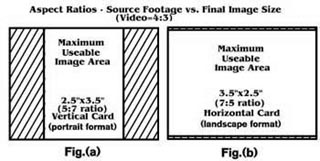Lenticular Animation Art PreperationLenticular Animation art preperation and setup. What you need to know about creating image files for animated lenticular printing.
Full motion animation footage can be captured from a variety of sources--motion picture film, video, stop motion photography, time lapse, DVD, etc. However, several "rules of thumb" should be observed when selecting footage for your project.
1. RESOLUTION OF SOURCE FOOTAGE VS. FINAL REPRODUCTION SIZE
VHS video typically has a horizontal resolution of less than 425 lines, Digital Beta has typically 525 lines of horizontal resolution, while digitized motion picture film can have as much as 4,000 lines of resolution. Bearing these resolutions in mind, digitized motion picture film can obviously be enlarged to much larger dimensions than VHS or Beta before "pixelation" or "artifacts" become visibly apparent.
2. ASPECT RATIO OF SOURCE FOOTAGE VS. ASPECT RATIO OF FINAL IMAGE
Final image dimensions must fit within the aspect ratio of the source footage. This directly affects point 1 in this section. An example can be taken from a sporting card produced from video source footage. Video maintains a 4:3 aspect ratio while a sport card typically trims at 2.5"X3.5"(vertical portrait format) or at 3.5"X2.5"(horizontal landscape format) for aspect ratios of 5:7 and 7:5 respectively. In this case, one can observe in illustration( ) that figure(b) encompasses more of the video image than figure(a) and can be enlarged correspondingly larger than figure(a)(refer to point 1) as more pixel data is included in the image.

3. CAMERA AND/OR SUBJECT MOVEMENT WITHIN THE SCENE
Extreme movement of camera and/or subject within the scene can result in a confusing final image. Caveats to this rule are:
a) When the camera pans, dollies, or trucks with the subject in a manner such that the subject maintains a relatively stationary position within the composition or frame.
b) Aspect ratio of the final image allows enough top to bottom or side to side room to reregister the individual frames such that the subject maintains a relatively
stationary position within the composition. Unfortunately, this decreases the amount of useable image data and limits the amount of enlargement that can be performed before pixelation becomes visibly apparent.
4. IF POSSIBLE, CYCLIC MOTION IS PREFERRED
A cycle, or cyclic motion, can best be described as a sequence where the first and last frames of motion coincide to produce continual motion when looped. Simply, the motion of walking, running, a bouncing ball, yo-yo, or spinning wheel are good examples of cyclic motion.
Copyright (C) 1999-2016 Digillax Systems and Parallax Pictures. All rights reserved.
|


